Physical Address
304 North Cardinal St.
Dorchester Center, MA 02124
Pains that involve the face, head, and neck are very common in clinical practice. These painful conditions are often unique and deserving of special attention.
The common descriptive terms for orofacial pain symptoms are frequently misleading. To avoid confusion, pain clinicians should be familiar with the International Headache Society’s Diagnostic Criteria for Head and Neck Disorders, the ICOP, and the diagnostic criteria for TMD. Clinicians should be comfortable distinguishing painful conditions that arise from structural pathology, neurovascular pain, painful musculoskeletal disorders, and orofacial neuropathic conditions.
Clinicians should be familiar with the clinically relevant head and neck anatomy features and the distinctive neurobiology of pain transmission in this region.
Chronic/recurrent painful disorders are extremely common in the head and neck, and myofascial pain disorders are among the most common causes of pain and dysfunction in this group. Myofascial pain overlaps several common diagnoses, including TMJ dysfunction, tension headache, and most occipital neuralgia cases. Clinicians should know the diagnostic features, potential etiologies, and exacerbating factors for such disorders. They should also understand how these factors are associated with the various multi-disciplinary options currently recommended for treatment.
Clinicians should know the unique anatomy and physiology of the TMJ and how jaw position and dental occlusion can contribute to TMD pain symptoms.
Oral appliances in conjunction with stress management and physical therapy may be a viable treatment option for patients with TMD.
TN is a unique neurogenic disorder. Patients who meet the clinical TN diagnostic criteria may benefit substantially from anti-convulsant drugs. When pharmacotherapy is exhausted, surgical treatment could be indicated. Patients with other forms of neurogenic facial pain may have a poorer prognosis.
Orofacial pain (OFP) refers to pain associated with the face, head, and neck and can be associated with the masticatory and cervical muscles, temporomandibular joint, intraoral tissues, salivary glands, and others. , It can be classified into the following categories: musculoskeletal, neurovascular, and neuropathic orofacial pain conditions.
Orofacial pain disorders have complex anatomy and specialized sensory innervations of the head and neck. Many orofacial pain disorders are unique and represent a clinical diagnostic challenge. Patients may present with one entity to multiple types of orofacial pain. This chapter presents an introduction to practical issues regarding assessment, diagnosis, and management of common orofacial pain disorders.
Other forms of orofacial pain, such as odontogenic pain, will not be discussed in this chapter since these conditions are usually already ruled out by a general dentist or other dental specialist.
The specialized structures of the head and face have a rich sensory innervation supplied by the trigeminal system, lower cranial nerves, and upper cervical roots. Pain is one of the most prominent symptoms of disease in this area. Usually, the acute pain symptoms closely correlate with other signs and symptoms of the disease. However, the correlation between pain and other symptoms may not be evident in several more complex, chronic pain problems, particularly those involving the masticatory system.
Chronic pain affects approximately 100 million adults in the United States, with an economic burden of over 600 billion. OFP is one of the most common pain conditions; its prevalence is estimated to be between 17%–26% in the general population, and 22% of the population suffered at least one orofacial pain in the length of six months. , Similar to other pain conditions, OFP is more prevalent in females than males. , After toothache, temporomandibular disorder (TMD) is the most common orofacial pain. In a large prospective multi-site study, the incidence of TMD was 3.9% annually, and females had only slightly higher incidence than males. The onset and chronification of TMD are associated with other comorbid pain conditions like chronic wide spread pain, lower back pain, and headaches ( Fig. 40.1 ). The prevalence of TMD depends on the illness in question, the diagnostic criteria used to identify the disease, and the study population. For example, in a review study that used the Research Diagnostic Criteria for Temporomandibular Disorder (RDC/TMD) as the diagnostic criteria for TMD, the general population prevalence of temporomandibular joint (TMJ) pain was 2.6%, muscle disorders had a prevalence of 9.7%, in comparison, the prevalence of these conditions in the patient population was 45.3% and 30.1%, respectively. , Unlike TMD that has a recognized and validated diagnostic criteria in the RDC/TMD and Diagnostic Criteria for Temporomandibular Disorder (DC/TMD), , the prevalence and incidence of several OFP conditions, for example, neurovascular orofacial pain, are unknown because until recently they were not defined in a comprehensive, internationally acceptable comprehensive classification. ,
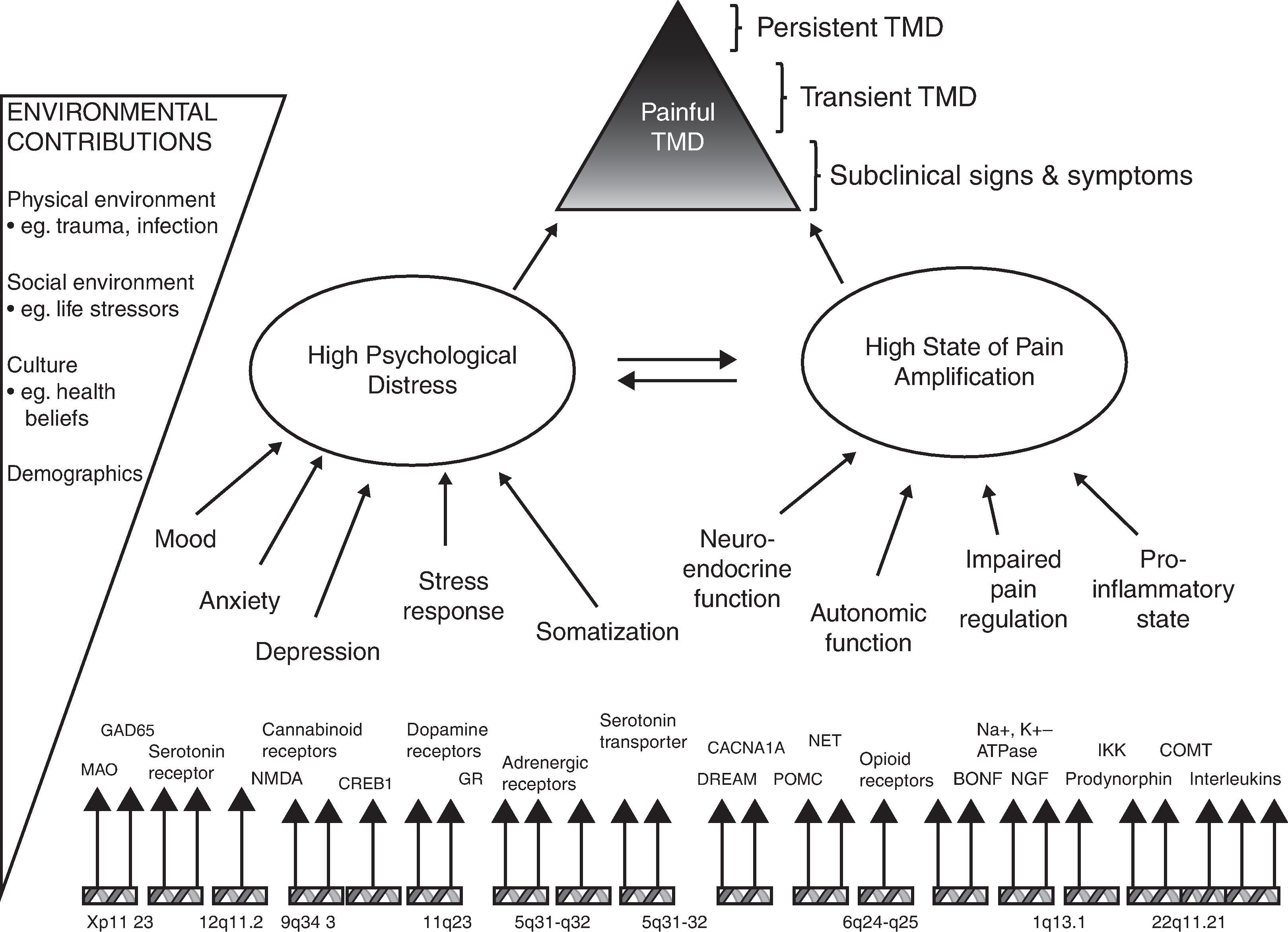
Several classifications have been developed over the years to better categorize the types of OFP. These classifications include the International Classification of Headache Disorders (ICHD-3) and the International Classification of Orofacial Pain (ICOP). Despite the fact these two classifications include TMD, a more specific classification for TMD was developed to assist researchers and clinicians, the first one was developed in 1992, RDC/TMD, and in 2014, DC/TMD. A summary of orofacial pain classifications is shown in Figure 40.2 .
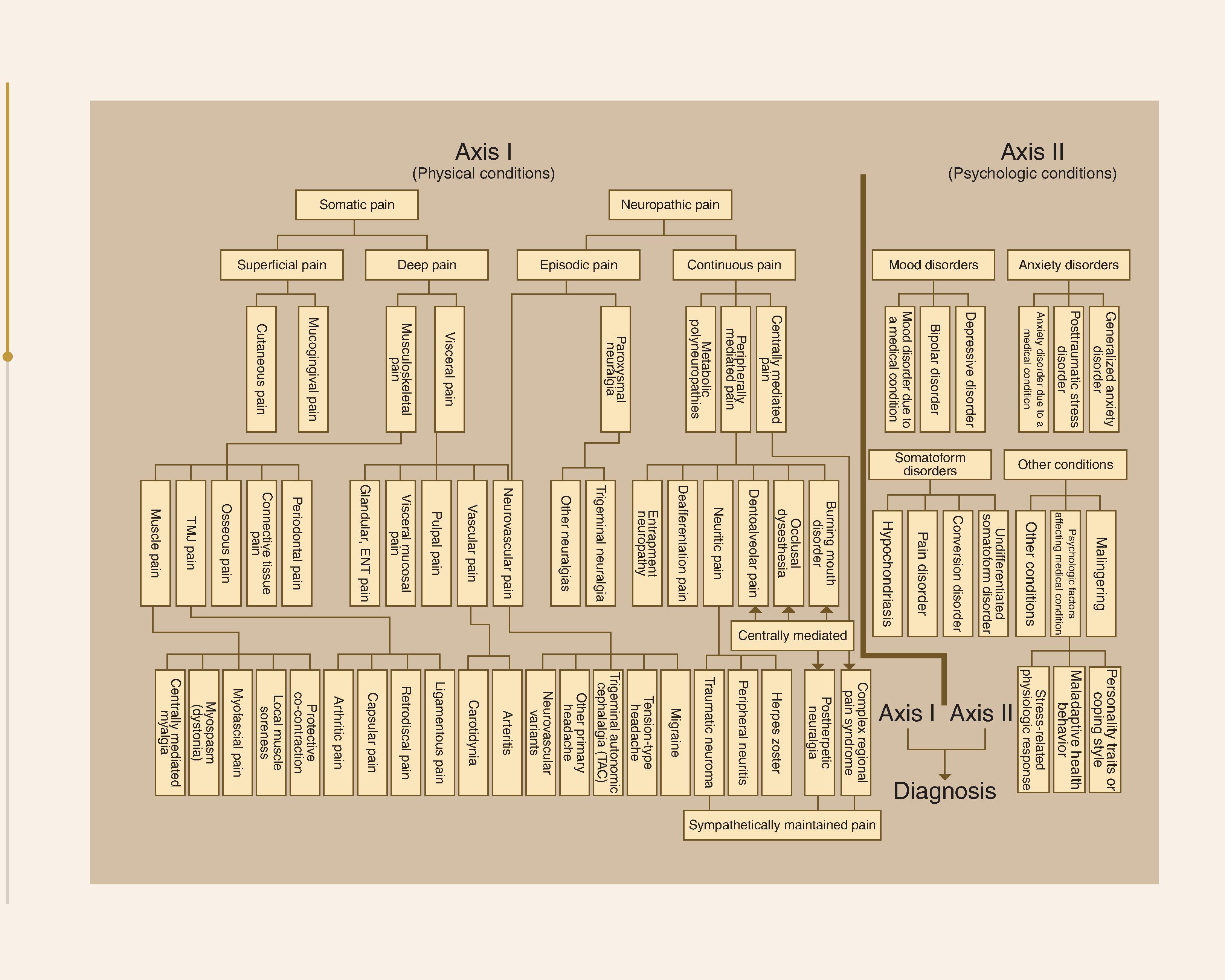
TMDs are defined as a subgroup of orofacial pain that involves the TMJ, masticatory muscles, and associated head and neck musculoskeletal structures.
Patients with TMD most frequently present with pain, limited or asymmetric mandibular range of motion, and TMJ sounds. , The pain or discomfort is often localized to the jaw, TMJ, and muscles of mastication, and cervical muscles are commonly involved. Commonly associated symptoms include ear pain and stuffiness, tinnitus, dizziness, neck pain, and headache. In some cases, the onset is acute, and symptoms are mild and self-limiting. However, about 15% of patients will develop chronic TMD, with persistent pain in association with physical, behavioral, psychological, and psychosocial symptoms similar to those of patients with chronic pain syndromes in other areas of the body (e.g. arthritis, low back pain, chronic headache, fibromyalgia, chronic regional pain syndrome, irritable bowel syndrome), all requiring a coordinated interdisciplinary diagnostic and treatment approach.
In 1934, Costen, an otolaryngologist, evaluated 13 patients who presented with pain in or near the ear, tinnitus, dizziness, a sensation of ear fullness, and difficulty swallowing. He observed that these patients had many missing teeth and, as a result, their mandibles were over closed. The patients seemed to improve when their missing teeth were replaced, and the proper vertical dimension of the occlusion was restored. The malocclusion and improper jaw position were perceived to be the cause both of “disturbed function of the TMJ” and the associated facial pain. The emphasis of treatment was on altering the affected patient’s occlusion.
More recently, advances in the understanding of joint biomechanics, neuromuscular physiology, autoimmune, musculoskeletal disorders, and pain mechanisms have resulted in changing concepts of the etiology of TMDs. These disorders are now considered multifactorial in etiology, with biologic, behavioral, environmental, social, emotional, and cognitive factors alone or in combination contributing to the development of signs and symptoms of TMDs ( Fig. 40.1 ). , , ,
Various forms of trauma to the TMJ structures (ligaments, articular cartilage, articular disc, bone) can lead to intraarticular biochemical alterations that have been demonstrated to produce oxidative stress and the generation of free-radicals. Subsequent inflammatory changes in synovial fluid with the production of a variety of pro-inflammatory cytokines can then lead to alteration in the functioning of normal tissues and degenerative disease in the TMJ.
Genetic marker studies involving catecholamine metabolism and adrenergic receptors suggest that certain gene polymorphisms (e.g. in the catechol-O-methyl transferase gene) might be associated with changes seen in pain responsiveness and pain processing in patients with chronic TMDs.
Differences in pain modulation have been reported between women and men with TMDs; women have been observed to demonstrate decreased thresholds to noxious stimuli and more hyperalgesia. In addition, in women with TMDs, some studies suggest that the affective component of pain may be enhanced during the low-estrogen phase of the menstrual cycle.
Functional brain imaging studies demonstrating changes in cortical circuitry support the concept that TMDs are very similar to other chronic pain disorders and may be related to abnormal pain processing in the trigeminal system. In particular, muscle pain disorders appear to have little, if any, abnormality of the muscles or peripheral tissues and may represent a central sensitization pain producing process. Because of the central sensitization, TMD was classified among other chronic painful disorders as part of the chronic overlapping pain conditions.
Lastly, numerous bio-behavioral studies support a connection between chronic TMDs and comorbid psychopathology (anxiety and depression disorders, posttraumatic stress disorder, and childhood physical, sexual, and psychological abuse). TMDs fall in the 11th major category of the International Headache Society’s (ICHD-3) classification. However, most researchers use the RDC/TMD or DC TMD for diagnosis purposes. ,
The TMJ is a ginglymoarthrodial synovial joint capable of rotational and translational movements. A bilateral joint (a single bone—the jaw—with a right and left joint) cannot function separately. What affects one joint also influences the other. It is formed by the articulation of the mandibular condyle with the glenoid fossa/articular eminence of the temporal bone.
The articular surfaces of the condyle and glenoid fossa/articular eminence are covered with fibrocartilage rather than hyaline cartilage, as in other synovial joints except for the clavicle. Fibrocartilage can resist heavy loads and has unique healing and adaptive properties.
An articular disc, made of fibrocartilage, is interposed between the condyle and the glenoid fossa. The disc has a biconcave shape; thicker in its anterior (2 mm) and posterior (3 mm) portions and thinner in the middle. It acts as a “cushion” to absorb stress, distribute loads, and facilitate jaw movements.
The disc divides each TMJ into two articular joint spaces: upper and lower joint space. The rotational movement happens mainly in the inferior joint space, between the condyle and the inferior surface of the disc. The translational movement in the upper joint space, between the upper surface of the disc and the glenoid fossa/articular eminence. ,
The most common TMJ disorders are:
Joint pain (arthralgia, arthritis)
Joint disorders (internal derangement or disc-condyle disorders)
Joint diseases (degenerative joint disease [DJD]: osteoarthrosis and osteoarthritis)
Joint pain is characterized by localized pain exacerbated by function, parafunction, and provocation.
According to the DC/TMD, arthralgia is defined as pain of joint origin affected by jaw movement, function, or parafunction, and the replication of the pain occurs during provocation testing of the TMJ.
History has to be positive for both:
pain in the jaw, temple, ear, or in front of the ear AND
pain modified with jaw movement, function, or parafunction
The clinical examination has to be positive for both:
confirmation of pain location in the area of the TMJ(s)
report of familiar pain in the TMJ with at least one provocation test:
palpation of the lateral pole (0.5 kg pressure) or around the lateral pole (1 kg pressure) OR
maximum unassisted or assisted opening, right or left lateral movements, or protrusive movements
Defined as pain of joint origin with clinical characteristics of inflammation or infection: edema, erythema, and/or increased temperature. It may result from trauma. In case of severe unilateral intraarticular swelling or effusion, it could be associated with occlusal changes such as ipsilateral posterior open bite. It is a localized condition, and there should not be a history of systemic inflammatory disease.
History has to be positive for both:
arthralgia AND
swelling, redness, and/or increased temperature in front of the ear OR
dental occlusal changes (posterior open bite) resulting from intraarticular inflammatory exudate
Clinical examination has to be positive for both:
arthralgia AND
presence of edema, erythema, and/or increased temperature over the joint OR
reduction in dental occlusal contacts noted between two consecutive measurements
The patient has to be negative for rheumatologic disease, including those in systemic arthritis, and the pain is not better accounted for by another pain diagnosis.
Internal derangement (or disc- condyle complex disorders) is defined as an “abnormal relationship of the articular disc to the mandibular condyle, glenoid fossa and articular eminence, interfering with the smooth movements of the joint.” It is a localized mechanical disorder within the joint. The term is often used as a synonym for disc displacement.
The clinical manifestations of internal derangements are clicking joint, intermittent locking, limited mouth opening (closed lock), and open lock.
The DC/TMD includes several forms of internal derangement:
Disc displacement with reduction
Disc displacement with reduction with intermittent locking
Disc displacement without reduction with limited opening
Disc displacement without reduction without limited opening
Disc displacements are usually anterior or anteromedial, although posterior and lateral displacements have been described in the literature. This may be partly related to the thinnest discal attachments being on the lateral pole of the condyle and the medial direction of pull by the lateral pterygoid and inward direction of condylar movement during mouth opening. Therefore disc displacement clinically suggests torn or stretched collateral discal ligaments that bind the disc to the condyle.
In disc displacement with reduction, clicking sounds on mouth opening and closing may be present . The term reduction is used to describe the misaligned disc temporarily coming back (or slipping back) to its proper interposition between the condyle and articular eminence/fossa during full opening ( Fig. 40.3 ). On closing the mouth, the disc again displaces as the teeth come closer together. This repetitive, ongoing displacement on opening and closing produces a reciprocal noise (clicks) and is hence termed reciprocal clicking ( Fig. 40.4 ). This stage may actually represent a physiologic accommodative stage without the need for therapy other than discussion regarding its anatomic significance.
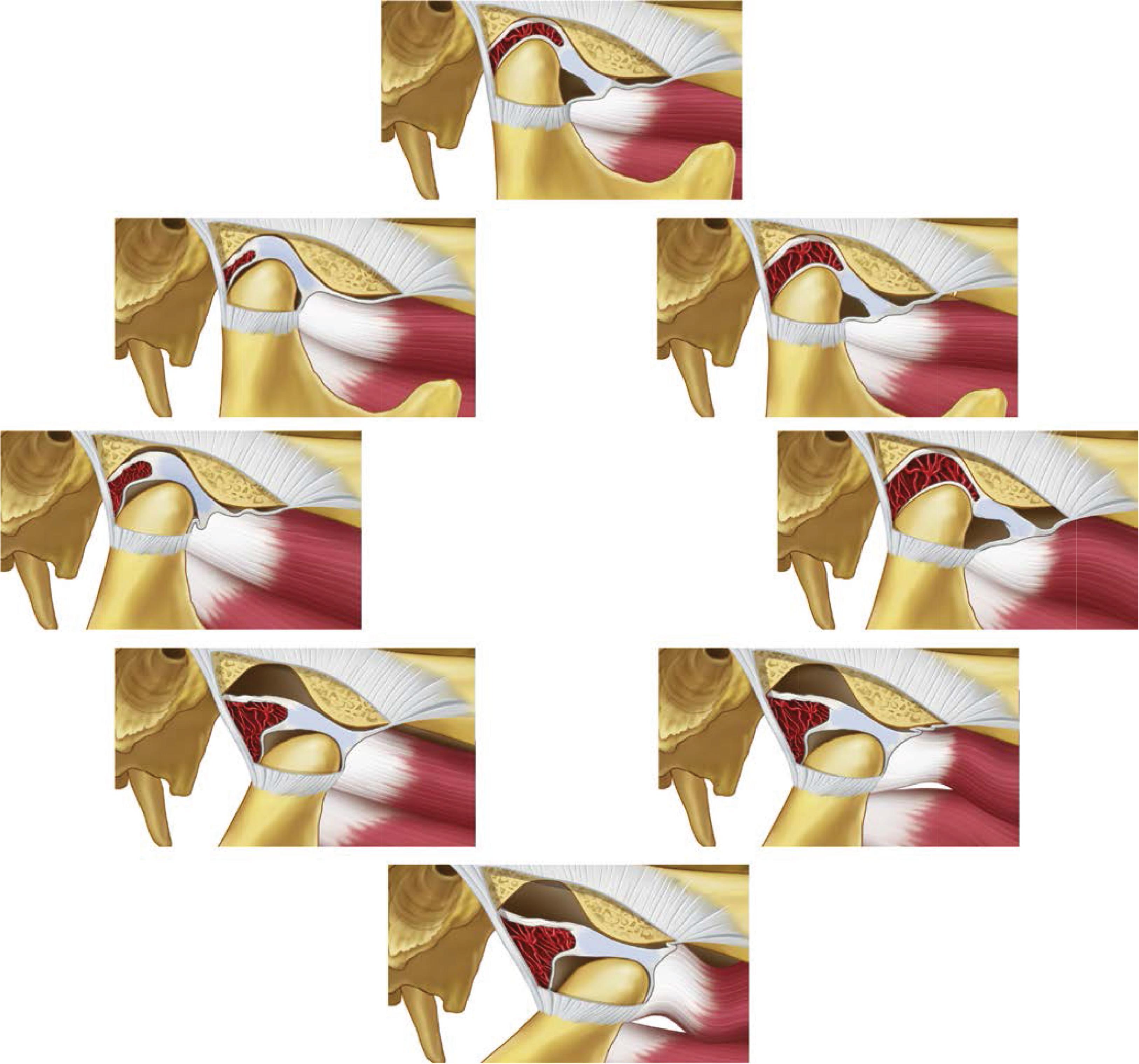
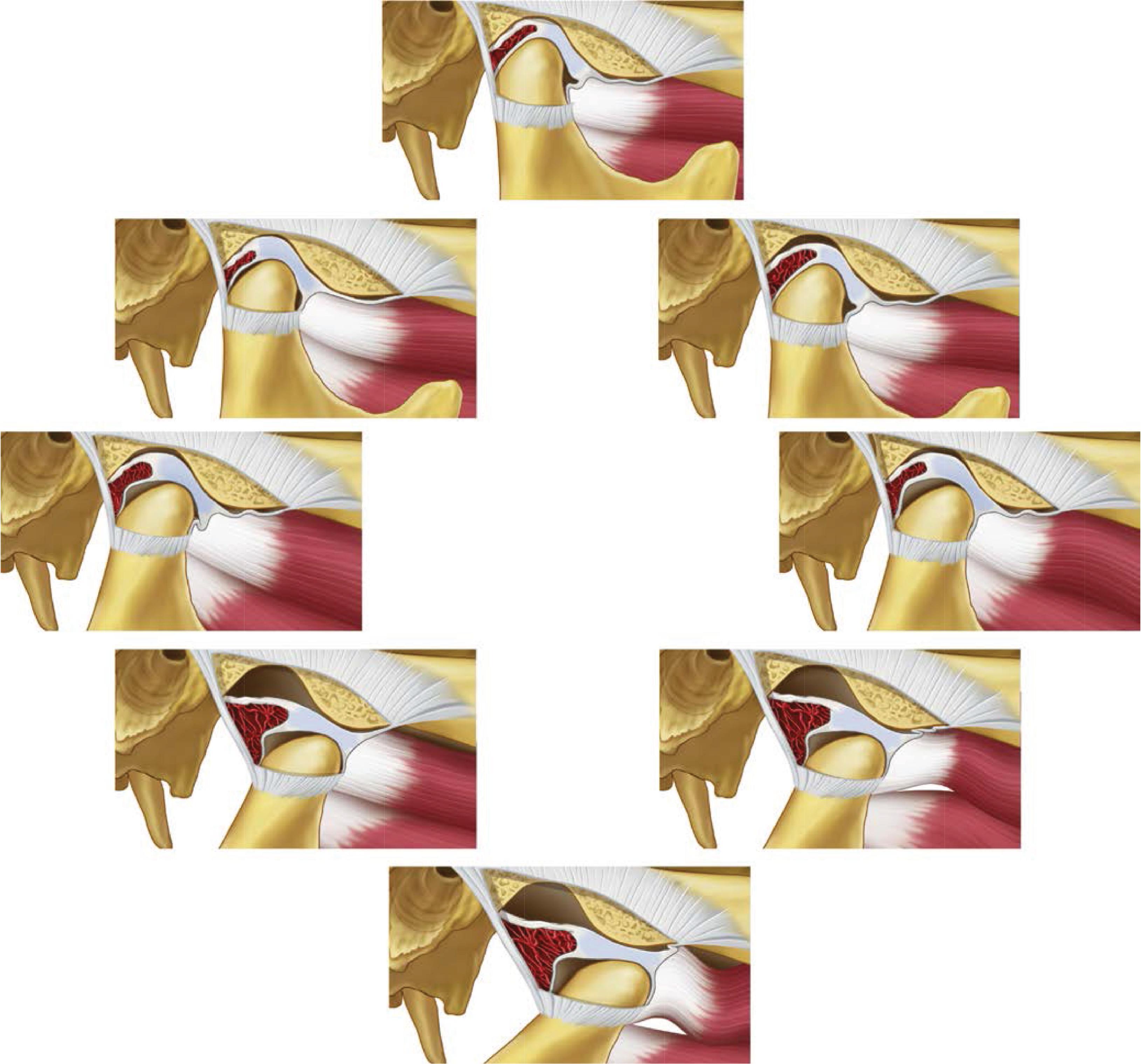
History has to be positive for at least one of:
in the last 30 days, any TMJ noise present with jaw movement or function OR
patient report of any noise present during the exam
The clinical exam has to be positive for at least one:
clicking, popping, and/or snapping noise during both opening and closing movements, detected with palpation during at least one of three repetitions of jaw opening and closing movements OR
clicking, popping, and/or snapping noise detected with palpation during at least one of three repetitions of opening or closing movements AND
clicking, popping, and/or snapping noise detected with palpation during at least one of three repetitions of right or left lateral or protrusive movements.
Imaging is the reference standard, and when this diagnosis needs to be confirmed with TMJ magnetic resonance imaging (MRI):
in the maximum intercuspal position, the posterior band of the disc is located anterior to the 11:30 position, and the intermediate zone of the disc is anterior to the condylar head AND
on full opening, the intermediate zone of the disc is located between the condylar head and the articular eminence.
In this intracapsular disorder, the disc does not reduce during mouth opening, causing intermittent, limited mandibular opening. Usually, the patient can unlock the joint.
History has to be positive for:
in the last 30 days, any TMJ noise present with jaw movement or function OR
patient report of any noise present during the exam AND
in the last 30 days, jaw locks with limited mouth opening, even for a moment, and then unlocks.
The clinical exam has to be positive for at least one of:
clicking, popping, and/or snapping noise detected during both opening and closing movements, detected with palpation during at least one of three repetitions of jaw opening and closing movements OR
clicking, popping, and/or snapping noise detected with palpation during at least one of three repetitions of right or left lateral or protrusive movements
When this diagnosis needs to be confirmed, the imaging analysis criteria are the same as for disc displacement with a reduction.
Disc displacement without reduction is sometimes called a “closed lock.” This suggests that the disc has been permanently displaced, and the disc’s shape has been permanently changed such that it physically prevents the condyle of the mandible from translating to a fully open position ( Fig. 40.5 ). There is a limitation of jaw opening to 22 to 25 mm with pain and a deflection of the mandible to the side of the lock. There is a reduction in the chewing capability because of pain, inflammation at the affected joint, and possible changes in the normal occlusion or “bite.” An MRI of the TMJ is the “gold standard” to assess soft tissue details of the articular disc and its displacement, while hard tissue CBCT scans are generally done to assess chronic osteoarthritic or bony changes. , Considering its positive natural course, treatment should be reserved for painful symptomatic cases, and it should always be conservative (see the section on treatment). The goal of the treatment is the management of pain and improvement in mouth opening. ,
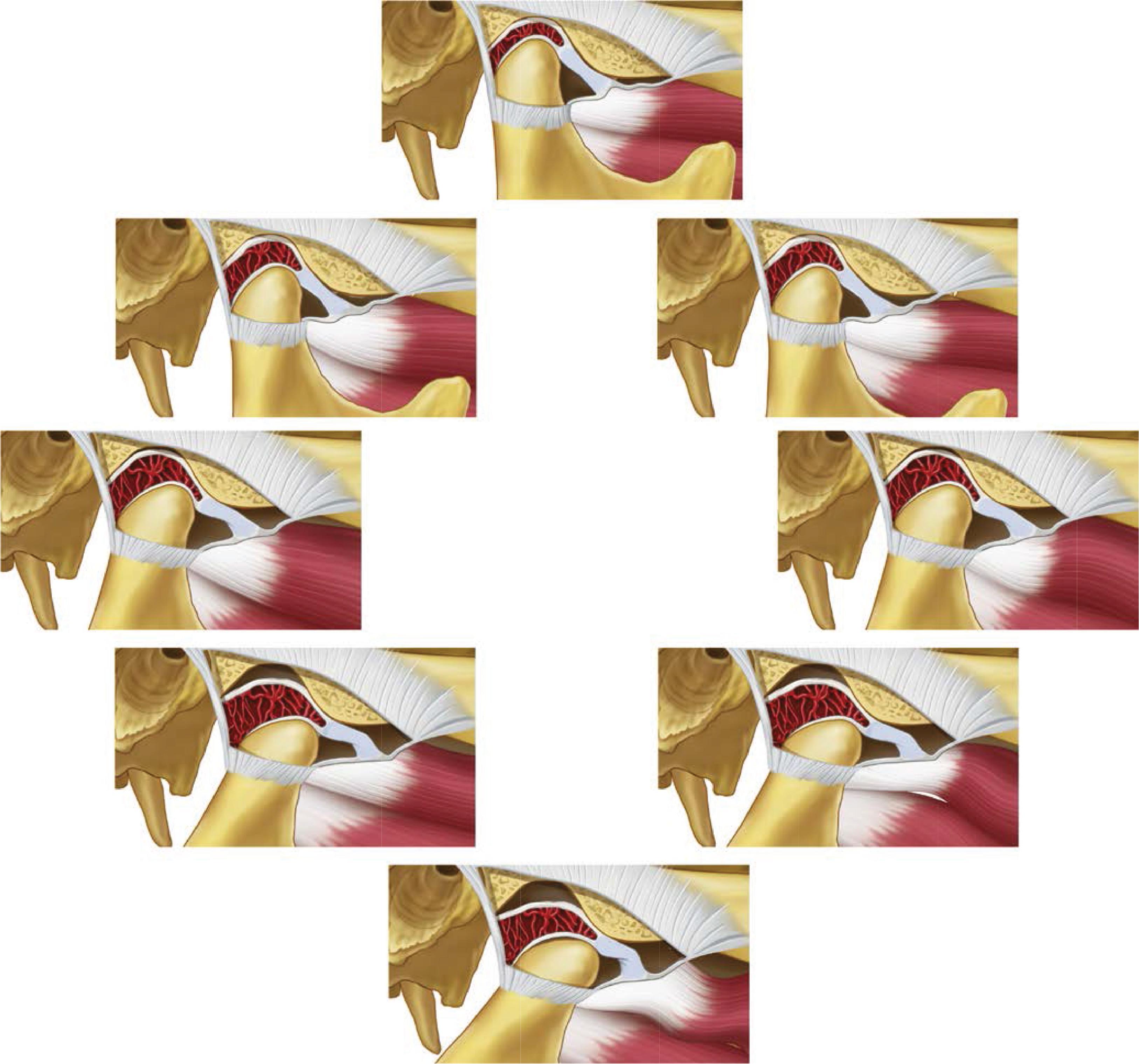
History has to be positive for both:
jaw locked so that the mouth would not open all the way AND
limitation in jaw opening severe enough to limit jaw opening and interfere with the ability to eat
The clinical exam has to be positive for:
Maximum assisted opening (passive stretch) movement including vertical incisal overlap <40 mm
When this diagnosis needs to be confirmed, the TMJ MRI criteria are positive for both:
in the maximum intercuspal position, the posterior band of the disc is located anterior to the 11.30 position, and the intermediate zone of the disc is anterior to the condylar head AND
on full opening, the intermediate zone of the disc is located anterior to the condylar head
The disc is still permanently displaced in this condition, but the clinical presentation is different: pain is often absent, and there is a restoration of function with normal maximum mouth opening.
History has to be positive for both in the past:
jaw locked so that the mouth would not open all the way AND
limitation in jaw opening severe enough to limit jaw opening and interfere with the ability to eat
The clinical exam has to be positive for:
Maximum assisted opening (passive stretch) movement including vertical incisal overlap >40 mm
When this diagnosis needs to be confirmed, TMJ MRI criteria are the same as for disc displacement without reduction with limited opening.
In the DC/TMD classification, DJD is defined as a degenerative disorder involving the joint characterized by deterioration of articular tissue with concomitant osseous changes in the condyle and/or articular eminence. DJD can result in dental malocclusions, including an anterior open bite, especially when present bilaterally or contralateral posterior open bite when present unilaterally.
DJD can be subclassified in:
Osteoarthrosis (DJD without arthralgia)
Osteoarthritis (DJD with arthralgia)
History has to be positive for at least one of:
in the last 30 days, any TMJ noise present with jaw movement or function OR
patient report of any noise present during the exam
The clinical exam has to be positive for:
crepitus detected with palpation during maximum unassisted opening, maximum assisted opening, lateral or protrusive movements
If imaging is needed to confirm the diagnosis, TMJ CT/CBCT criteria are positive at least for one of:
subchondral cyst, erosion, generalized sclerosis, osteophyte.
History has to be positive for both:
in the last 30 days, any TMJ noise present with jaw movement or function OR
patient report of any noise present during the exam AND
arthralgia
Clinical examination has to be positive for both:
crepitus detected with palpation during maximum unassisted opening, maximum assisted opening, right or left lateral movements or protrusive movements AND
arthralgia
Imaging: same TMJ CT/CBCT criteria as for osteoarthrosis.
Become a Clinical Tree membership for Full access and enjoy Unlimited articles
If you are a member. Log in here